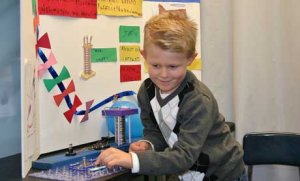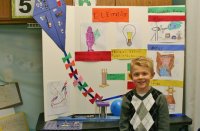A Joyful, Brain-Friendly Classroom
Your content has been saved!
Go to My Saved Content.I took my handicapped dog of 15 years for a walk in the grass. Maddie has gone from not being able to walk on her hind legs (a neurological problem) to gradually being able to walk with an awkward, back-legs-don't-really-know-where-they're-landing gait. Let me relate Maddie’s experience to brain-compatible elements that my teachers implement at New Morning School every day.
I provide my dog with the choice to engage in walking every day; she loves it. When children engage in activities they view as pleasurable, and when the projects are ones they have chosen, just as Maddie does, dopamine is released in the brain. This neurotransmitter increases attention and helps information to be stored in long-term memory.1
When children choose to engage in academic work, there is joy. Let's not lose track of one important goal of learning: making sense of the world for the pure joy of it. That is sniffing for a dog or joy of discovery for children. Learning will naturally follow.
Let's look at two examples of learning projects at New Morning School that reflect brain compatible elements. One, called Museum, happens annually. The other happened in kindergarten for an individual student. Both reflect best practice when taking into account how the brain learns best.
First Project: Museum
In Museum, a cornerstone of the school's program, each K-8 student chooses a topic of interest to research over an extended period. Inquiries range from Plimoth Plantation, horses or rainbows for the younger set to criminal investigation, immunology or Duke Ellington at the middle school level. This creates an ideal environment for children to experience choice, which increases attention and better storage of knowledge in long-term memory.2 Further, when students choose a topic of interest, there is sense and meaning. It creates a purpose for learning -- preparing information to share with others. This sense and meaning increases the likelihood of implanting information in long-term memory.3
Museum preparation is a busy time. In one corner of the classroom, a student is making a tornado, and another is creating a 3D map out of paper pulp. A third child is quietly reading to find the answer to "How many stingers does a jellyfish have?" The goal of Museum research is to create hands-on representations for Museum guests. Students may take a field trip, complete with a list of questions to answer in the field -- dinosaurs at the museum, reptiles at the zoo, interviewing a stockbroker about the stock market. All of these create "being there" experiences.4
The process skills of learning are the critical elements of real discovery:
- Asking a question and finding the answer
- Collaborating with peers
- Students reflecting on what they've learned and what they still want to learn
Each Museum topic becomes the vehicle through which children learn new content and tie in academic benchmarks. They map, model, graph, read, write, create surveys and dioramas, and represent their learning. The students learn many facts about their subject, but what matters most is that they are learning how to learn.
As Museum nears and there is important work to complete, students may be working on their project for up to two hours at a stretch. There are no bells, no deadlines. This is the ultimate in offering students the opportunity to engage in meaningful and exciting work.

Finally, Museum day arrives. Families, friends and community members arrive to be greeted by each student standing at his or her display. They might get to pet a rabbit at one display, sample Japanese food at another, or view a student-made video presentation at a third stop.
There are many ways that students reflect on their Museum learning, a necessary component to consolidate learning. They communicate with the Museum guests, providing an opportunity for public speaking and deep understanding of their topics. They fill out self-evaluation forms to "grade" themselves; the teachers do not complete a formal evaluation of the students' work. The learning matters to the students -- it's not just a grade imposed on their work.
Second Project: Making an Ear
Every afternoon in kindergarten is Reggio day, patterned on the educational approach in Reggio Emilia, Italy. Each student picks a question he or she would like to answer. One of the students, Chris, asked, "When you are listening with ear buds and you make the sound loud, why does it hurt your ears?" Once his question was set, choice began. Certainly there was sense and meaning, since he picked the topic. He had all afternoon to complete his work, knowing that he would share his findings at the end of the week.
With suggestions from his teacher, he explored vibration. He started out by saying that a paper cone was like the outside of his ear. The teacher suggested taping paper at the small end of the paper cone and talking into the cone. Amazement! When he did that, he could feel it; the paper vibrated. It still didn't meet his expectations, and he experimented with other materials to create the vibrating eardrum until he found what satisfied him -- a plastic cup. It worked! What could be a better example of immediate feedback? Here the teacher was not "correcting his paper," but rather, Chris was evaluating and modifying his own work.
Ways to Joyfully Create a Brain-Compatible Learning Environment
There are many aspects of a brain-compatible, joyful classroom. In this blog I've spoken to two important elements:
- Choice of activities and discovery
- Purposeful work through the child's eyes
We need to "listen" to children by observing and thinking about how we can guide -- but not dictate -- their learning. We can be partners in creating a joyful experience for each child, each and every day.
Notes
1&2Willis, Judy, M.D. How Your Child Learns Best: Brain-Friendly Strategies You Can Use to Ignite Your Child's Learning and Increase School Success. Naperville: Sourcebooks, Inc., 2008.
3Sousa, David. How the Brain Learns. Thousand Oaks: Corwin, 2011.
4Kovalik, Susan, and Karen Olsen. Exceeding Expectations: A User's Guide to Implementing Brain Research in the Classroom. Black Diamond: Books for Educators, Inc., 2010.
